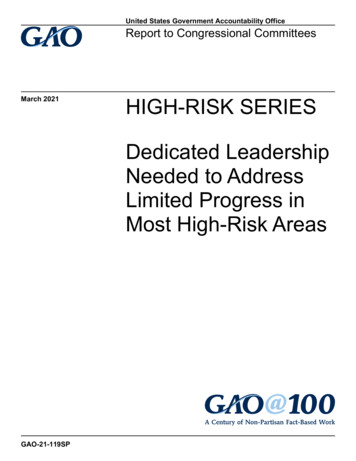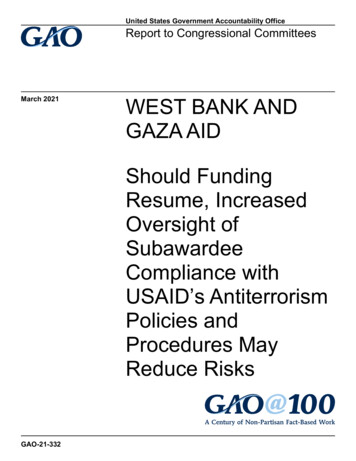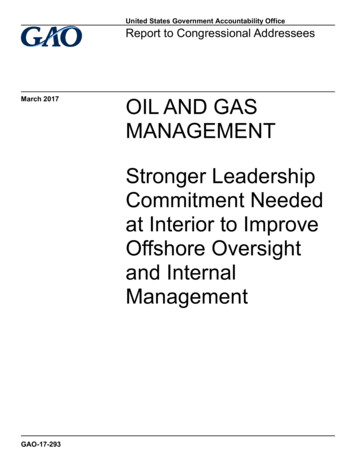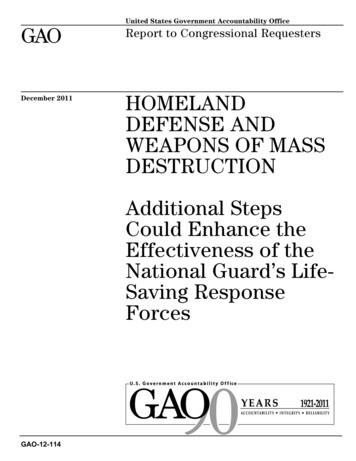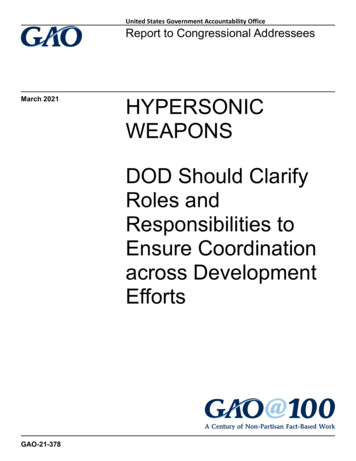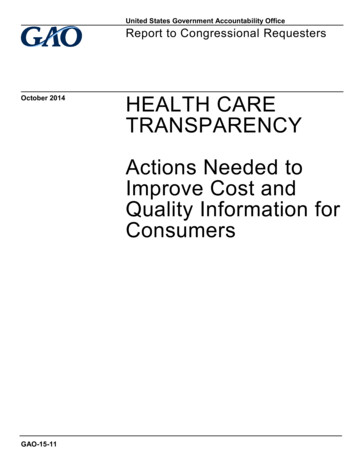
Transcription
United States Government Accountability OfficeReport to Congressional RequestersOctober 2014HEALTH CARETRANSPARENCYActions Needed toImprove Cost andQuality Information forConsumersGAO-15-11
October 2014HEALTH CARE TRANSPARENCYActions Needed to Improve Cost and QualityInformation for ConsumersHighlights of GAO-15-11, a report tocongressional requestersWhy GAO Did This StudyWhat GAO FoundThe cost and quality of health careservices can vary significantly, withhigh cost not necessarily indicatinghigh quality. As consumers pay for agrowing proportion of their care, theyhave an increased need for cost andquality information before they receivecare, so they can plan and makeinformed decisions. Transparency toolscan provide such information toconsumers and others.Results obtained from two selected private consumer transparency tools GAOreviewed—websites with health cost or quality information comparing differenthealth care providers—show that some providers are paid thousands of dollarsmore than others for the same service in the same geographic area, regardlessof the quality of such services. For example, the cost for maternity care atselected acute care hospitals in Boston, all of which rated highly on severalquality indicators, ranged between 6,834 and 21,554 in July 2014.GAO was asked to study cost andquality information for consumers. Thisreport examines (1) information on costand quality available to consumersfrom selected transparency tools,(2) characteristics of effectivetransparency tools, (3) limitations, ifany, in the effectiveness of CMStransparency tools, and (4) CMSefforts to expand cost and qualityinformation available throughtransparency tools. GAO analyzedinformation from two private tools—selected because they had both costand quality information—and CMS’sfive transparency tools, reviewedresearch to identify best practices forconveying information to consumers,interviewed CMS and HHS officialsand subject matter expects, andreviewed CMS and HHS planningdocuments and relevant criteria foreffective planning in the federalgovernment.What GAO RecommendsGAO recommends that HHS’s CMStake steps to improve the informationin its transparency tools and developprocedures and metrics to ensure thattools address consumers’ needs. HHSconcurred with the recommendationsand provided technical comments thatwere incorporated as appropriate.View GAO-15-11. For more information,contact Linda T. Kohn at (202) 512-7114 orkohnl@gao.gov.Transparency tools are most effective if they provide information relevant toconsumers and convey information in a way that consumers can readilyunderstand. GAO identified key characteristics of effective transparency toolsthrough a literature review and interviews with experts. The information that ismost relevant to consumers relates directly to their personal circumstances, suchas information on specific procedures they are considering, and allows them tomake meaningful distinctions among providers based on their performance.Characteristics of such relevant information include describing key differences inquality of care and costs, particularly for what consumers are likely to pay out ofpocket based on their specific circumstances. In addition, effective transparencytools must take specific steps to make the information they presentunderstandable by consumers. For example, tools must enable consumers todiscern patterns by summarizing related information and allowing consumers tocustomize information to focus on what is most relevant to them.The Centers for Medicare & Medicaid Services (CMS) operates five transparencytools—Nursing Home Compare, Dialysis Facility Compare, Home HealthCompare, Hospital Compare and Physician Compare—that are limited in theirprovision of relevant and understandable cost and quality information forconsumers. In particular, GAO found that the tools lack relevant information oncost and provide limited information on key differences in quality of care, whichhinders consumers’ ability to make meaningful distinctions among providersbased on their performance. Because none of the tools contain information onpatients’ out-of-pocket costs, they do not allow consumers to combine cost andquality information to assess the value of health care services or anticipate thecost of such services in advance. Additionally, GAO found substantial limitationsin how the CMS tools present information, such as, in general, not using clearlanguage and symbols, not summarizing and organizing information to highlightpatterns, and not enabling consumers to customize how information is presented.CMS, part of the Department of Health and Human Services (HHS), has takensome steps to expand access to cost and quality information for consumers, buthas not established procedures or metrics to ensure the information it collectsand reports meets consumer needs. Both HHS and CMS have set goals to reporton measures that meet consumer needs. However, CMS’s process fordeveloping and selecting cost and quality measures for its tools has been heavilyinfluenced by the concerns of providers rather than consumers. Withoutprocedures or metrics focusing on consumer needs, CMS cannot ensure thatthese efforts will produce cost and quality information that is relevant andunderstandable to consumers seeking to make meaningful distinctions.United States Government Accountability Office
ContentsLetter1BackgroundInformation from Two Selected Consumer Transparency ToolsConsistently Demonstrated Substantial Cost VariationRegardless of Quality for Certain ServicesEffective Transparency Tools Provide Cost and QualityInformation That Is Relevant and Understandable toConsumersCMS Transparency Tools Are Limited in Their Provision ofRelevant and Understandable Cost and Quality Information forConsumersCMS Has Taken Limited Steps to Expand Access to Cost andQuality Information, but Has Not Established Procedures toEnsure This Information Meets Consumer NeedsConclusionsRecommendations for Executive ActionAgency Comments and Our Evaluation24303132Examples of Variation in Cost and Quality Information Availableto Consumers for Selected Procedures35Appendix IIAssessment of CMS Transparency Tools41Appendix IIIComments from the Department of Health and Human Services42Appendix IVGAO Contact and Staff Acknowledgments46Appendix I6111419TablesTable 1: Types of Health Care Quality MeasuresTable 2: Existing and Expected Future Transparency Tools of theCenters for Medicare & Medicaid Services (CMS)Table 3: Information Obtained through Telephoning SelectedAmbulatory Surgical Centers and Hospital OutpatientDepartmentsPage i7913GAO-15-11 Health Cost and Quality Transparency
Table 4: Cost and Quality of a Laparoscopic Gallbladder Surgeryat Ambulatory Surgical Centers (ASCs) and HospitalOutpatient Departments in the Denver, Colorado-AreaTable 5: Cost and Quality of MRI of the Lower Back at StandAlone Imaging Centers and Acute Care Hospitals in theIndianapolis, Indiana AreaTable 6: Cost and Quality of Maternity Care at Acute CareHospitals in the Boston, Massachusetts AreaTable 7: Cost and Quality Information Obtained for an InguinalHernia Repair or Diagnostic Colonoscopy at AmbulatorySurgical Centers (ASC) and Hospital OutpatientDepartments in Two Health Care Markets Based onTelephoning Selected ProvidersTable 8: Assessment of CMS Transparency Tools on Relevanceand Understandability of Information for ConsumersPage ii3637383941GAO-15-11 Health Cost and Quality Transparency
MRIPPACAResDACQEAgency for Healthcare Research and QualityAll-payer-claims databaseambulatory surgical centerCenters for Medicare & Medicaid ServicesGovernment Performance and Results Act ModernizationAct of 2010Hospital Consumer Assessment of Healthcare Providersand SystemsDepartment of Health and Human Servicesinpatient rehabilitation facilityinformation technologyMeasure Applications Partnershipmagnetic resonance imagingPatient Protection and Affordable Care ActResearch Data Assistance CenterQualified EntityThis is a work of the U.S. government and is not subject to copyright protection in theUnited States. The published product may be reproduced and distributed in its entiretywithout further permission from GAO. However, because this work may containcopyrighted images or other material, permission from the copyright holder may benecessary if you wish to reproduce this material separately.Page iiiGAO-15-11 Health Cost and Quality Transparency
441 G St. N.W.Washington, DC 20548October 20, 2014Congressional RequestersThe cost and quality of health care services can vary significantly, withevidence suggesting that more expensive health care services are notnecessarily higher in quality. Providers, such as hospitals or physicians,may be paid two or three times more than similar providers for the samehealth care services, without delivering higher quality of care. 1 At thesame time, a growing proportion of health care costs are being paid byconsumers. Consumers without health insurance are generallyresponsible for paying what the provider charges, rather than discountedrates negotiated by insurance companies, while those with insurance alsoface increased costs, as use of high-deductible health plans and otherforms of cost sharing have increased. In particular, consumers whoseout-of-pocket costs are based on a percentage of the total cost of carecan be especially affected by cost variations. 2 Consumers may also facefees associated with care received from physicians, laboratories, orhospitals that are outside of an insurance network and bill for theirservices separately.As consumers are asked to pay more for their care, they run the risk ofobtaining care from high-cost providers without receiving the highestquality care. Therefore, consumers have an increased need fortransparent information on cost and quality before they receive care, sothey can make informed decisions when choosing treatments andproviders. Even when not faced with these decisions, consumers can usesuch information to better anticipate and plan for expenses. Together,information on both cost and quality enables consumers to assess the1See Massachusetts Attorney General, Examination of Health Care Cost Trends and CostDrivers (Boston, Mass.: 2011); Institute of Medicine, Variation in Health Care Spending:Target Decision Making, Not Geography (Washington, D.C.: 2013); and P.S. Hussey, S.Wertheimer, and A. Mehrotra, “The Association between Health Care Quality and Cost: ASystematic Review,” Annals of Internal Medicine, vol. 158, no. 1 (2013).2For example, Medicare patients are typically responsible for 20 percent of the costs ofthe physician services that they receive, after they meet their annual deductible. Onaverage, out-of-pocket costs for Medicare beneficiaries on medical and long-term careservices amounted to 2,744 per year in 2010. See J. Cubanski, et al., How Much IsEnough? Out-of-Pocket Spending Among Medicare Beneficiaries: A Chartbook, KaiserFamily Foundation (Menlo Park, Calif.: July 2014).Page 1GAO-15-11 Health Cost and Quality Transparency
value of health care services, for example by comparing costs within agroup of providers determined to be of high quality. Research suggeststhat this transparent information is most relevant for services that can beplanned in advance, so consumers have time to consider it. 3 We havepreviously found that this transparent information on cost and quality isdifficult for consumers to obtain, and that the information that is availableis not always meaningful to consumers. 4Transparency tools—websites with health cost or quality informationcomparing different providers of health care services—are one way thatthe Department of Health and Human Services (HHS) and otherorganizations provide this information to consumers and other users.HHS both publishes its own transparency tools and shares data on costand quality that other public or private entities can use in theirtransparency tools. Specifically, HHS publishes transparency toolsthrough its Centers for Medicare & Medicaid Services (CMS), such as itsseries of Compare websites for hospitals, nursing homes, and certainother providers that participate in the Medicare program.In light of variations in cost and quality and consumers’ increased needfor transparent information prior to receiving health care, you asked us tostudy the cost and quality information available to consumers. This reportexamines1. information on cost and quality available to consumers for selectedhealth care services from selected private transparency tools,2. characteristics of effective transparency tools,3. limitations, if any, in the effectiveness of CMS transparency tools inproviding cost and quality information about providers to consumers,and3For example, to assist decision making, research suggests that health care pricetransparency is most relevant for consumers who are having services that are nonurgent,such as a knee replacement, or not complex, such as a colonoscopy. See, for example,Paul Ginsburg. “Shopping for Price in Medical Care,” Health Affairs, vol. 26, no. 2 (2007).4GAO, Health Care Price Transparency: Meaningful Price Information is Difficult forConsumers to Obtain Prior to Receiving Care, GAO-11-791 (Washington, D.C.: 2011);GAO, Nursing Homes: CMS Needs Milestones and Timelines to Ensure Goals for theFive-Star Quality Rating System Are Met, GAO-12-390 (Washington, D.C.: 2012).Page 2GAO-15-11 Health Cost and Quality Transparency
4. CMS efforts to expand cost and quality information that could bemade available to consumers through transparency tools.To examine information on cost and quality available to consumers forselected health care services from selected private transparency tools,we obtained examples of information from the transparency tools of ahealth insurer and Castlight Health, a third-party vendor. 5 We selectedthese tools based on their capacity to provide consumer-relevant costinformation on services that could be planned in advance, as well assome related information on quality of care. Within these tools, weselected services, provider types, and geographic locations based oneach tool’s ability to provide cost and quality information for thoseservices, provider types, and locations. The selected services were:laparoscopic gallbladder surgery, magnetic resonance imaging (MRI) ofthe lower back, and maternity care. The selected providers were:ambulatory surgical centers (ASC), hospital outpatient departments, andacute care hospitals. The selected locations were: Boston(Massachusetts), Indianapolis (Indiana), and Denver (Colorado). Both thehealth insurer and Castlight provided cost information based on aninsurance plan common for their customers. 6 We reviewed relateddocumentation and interviewed knowledgeable company officials, anddetermined that the data were sufficiently reliable for our purposes. Thefindings from these transparency tools cannot be generalized to othertools. To determine the availability to consumers of cost and quality datain the absence of transparency tools, we directly contacted 24 randomlyselected ASCs and hospital outpatient departments in Minneapolis(Minnesota) and Portland (Oregon) health care markets by telephone. 7We selected these locations because each of these states had cost andquality initiatives to provide information to consumers, and each market5Castlight serves employers who provide cost and quality health information to theiremployees.6The health insurer provided estimates based on a point-of-service, high-deductible planoffered by employers. Castlight provided estimates based on a standard health plan with a 2,000 deductible, 5,000 out-of-pocket maximum, 100 percent coverage for certainpreventive services, and 80 percent in-network coverage after application of thedeductible. A point-of-service plan is a hybrid of a preferred provider organization plan anda health maintenance organization plan. It resembles a health maintenance organizationplan for in-network services, and services received outside of the network are usuallyreimbursed based on a fee schedule or usual and customary charges.7We contacted each provider up to three times in an attempt to get a response betweenMay 28 and July 7, 2014.Page 3GAO-15-11 Health Cost and Quality Transparency
had the largest number of hospitals in those states. 8 During the calls werequested the cost of two services for an uninsured patient—an inguinalhernia repair and a diagnostic colonoscopy, as well as requested anyquality information available for the service or facility. These two serviceswere selected because each could be planned in advance and iscommonly performed in an ambulatory setting. We did not assess theaccuracy of the cost and quality information provided by these selectedproviders.To examine characteristics of effective transparency tools, we reviewedthe literature on best practices for conveying cost and quality informationto consumers and interviewed subject matter experts. We searchedmultiple online databases to identify relevant articles and reportspublished from 2008 to 2013, 9 the most recent available at the time of ourwork. We also identified nine researchers as experts on the basis of theirpublications and other activities in the area of communicating cost andquality information to consumers. Six of these experts provided theirperspectives in interviews. We synthesized our literature review andinterviews into a draft description of key characteristics of effectivetransparency tools, and then obtained comments from the remainingthree consumer transparency experts and revised the description of thecharacteristics as appropriate.8We used hospital referral regions, as defined by the Dartmouth Atlas of Health Care, toidentify these regional health care markets. We randomly selected ASCs and hospitals tocontact from the National Provider Identifier Registry.Minnesota’s transparency tools include: Minnesota Hospital Price Check, MinnesotaHealthScores, Minnesota Nursing Home Report Card, and Minnesota CommunityMeasurement Health Care Quality Report. Oregon’s transparency tools include: OregonPricePoint, Compare Hospital Costs, and Partner for Quality Care. We also selectedMinnesota because it requires providers to make estimated costs of treatment andestimated costs that must be paid by the patient available upon request. See Minn. Stat.§§ 62J.81-62J.823.9Databases we searched included the ABI/Inform Professional Advanced; Allied &Complementary Medicine; BIOSIS Previews; British Library Inside Conferences; BritishNursing Index; Embase; Emcare; Gale Group Health Periodicals Database; HSELINE:Health and Safety; Incidence & Prevalence; International Pharmaceutical Abstracts; King’sFund; MEDLINE; National Technical Information Service; Public Affairs InformationService International; PsycINFO; SciSearch; Social SciSearch; ProQuest; and Web ofScience.Page 4GAO-15-11 Health Cost and Quality Transparency
To examine the limitations, if any, in the effectiveness of CMStransparency tools in providing cost and quality information aboutproviders to consumers, we identified five CMS transparency tools thatprovide comparative cost or quality information about providers: HospitalCompare, Nursing Home Compare, Dialysis Facility Compare, HomeHealth Compare, and Physician Compare. We then reviewed each tool todetermine the extent to which it had characteristics of effectivetransparency tools, using the list we identified in our second objective. Weinterviewed CMS officials responsible for planning, developing and testingthe HHS transparency tools, and reviewed HHS documentation on theprocess for developing the tools and HHS’s future plans for improving thetools.To examine CMS efforts to expand cost and quality information availableto consumers through transparency tools, we interviewed CMS and HHSofficials with oversight and involvement in public reporting and CMStransparency initiatives, including officials who develop and maintainCMS’s Compare websites. We also reviewed HHS strategic planningdocuments related to health care quality and public reporting, andreviewed relevant criteria from the Government Performance and ResultsAct Modernization Act of 2010 (GPRAMA) as incorporated in ourguidance on assessing performance. 10 We then interviewed consumertransparency experts, as noted above, and officials representing privateand state-sponsored organizations that use CMS data in theirtransparency tools to identify CMS and other HHS agency actions thatcould help to expand information available to consumers. Because ourstudy focused on CMS’s efforts to promote transparency for consumers,we did not examine other factors affecting access to cost and qualityinformation, such as barriers to obtaining information on payment ratesnegotiated between individual providers and private sector payers. 11We conducted this performance audit from December 2013 to October2014 in accordance with generally accepted government auditingstandards. Those standards require that we plan and perform the audit to10See Pub. L. No. 111-352, 124 Stat. 3866 (2011). GPRAMA amends the GovernmentPerformance and Results Act of 1993, Pub. L. No. 103-62, 107 Stat. 285 (1993); GAO,Executive Guide: Effectively Implementing the Government Performance and Results Act,GAO/GGD-96-118 (Washington, D.C.: June 1996).11See GAO-11-791 for more information on these other factors affecting access to costand quality information.Page 5GAO-15-11 Health Cost and Quality Transparency
obtain sufficient, appropriate evidence to provide a reasonable basis forour findings and conclusions based on our audit objectives. We believethat the evidence obtained provides a reasonable basis for our findingsand conclusions based on our audit objectives.BackgroundTransparency tools are a way to make information on health care costand quality transparent to consumers and others, and are a key part ofHHS’s strategy to improve the quality and affordability of health care.Information on HealthCare Cost and QualityThere are multiple ways to assess the cost of health care. For example,cost can be measured based on the amount of money providers set as a“charge” for various individual services, but these charges typically do notrepresent the actual amounts paid by insurers or consumers. The costthat an insured consumer is responsible for paying to receive services iscalled an out-of-pocket cost, which depends on the consumer’s individualprovider choices and insurance benefit design. 12 In addition, any givenepisode of care usually involves payments to multiple providers (e.g.,surgeons, anesthesiologists, pathologists, etc.), facility fees, and otherancillary fees, and any given cost figure may or may not represent thetotal costs for an episode of care by including all of these expenses.There also are a variety of different types of clinical quality measures—standard, evidence-based metrics used to assess the performance ofhealth care providers—that address different aspects of quality.According to HHS’s Agency for Healthcare Research and Quality’s(AHRQ) National Quality Measures Clearinghouse, types of qualitymeasures include, (1) structure, (2) process, (3) outcome, and (4) patientexperience of care. 13 (See table 1 for a description of types of qualitymeasures.)12For insured consumers, out-of-pocket payment typically includes copayments,coinsurance, and deductibles, which are affected by a number of variables such as theuse of out-of-network providers.13For a description of the quality measure categories, see Agency for HealthcareResearch and Quality, National Quality Measures tutorial/varieties.aspx, accessed August 5, 2014.The National Quality Measures Clearinghouse also includes other types of clinical qualitymeasures, such as access measures, which measure a patient’s ability to attain timelyand appropriate care.Page 6GAO-15-11 Health Cost and Quality Transparency
Table 1: Types of Health Care Quality MeasuresMeasure typeDescriptionExamplesStructuralReflect the conditions in which providers care forpatients.Measures about staffing levels or the volume ofprocedures performed by a provider.ProcessShow whether steps, or processes of care, that havebeen proven to benefit patients are followed correctly.Measures that indicate whether an action wascompleted—such as writing a prescription,administering a drug, or having a conversation.OutcomeReport the actual results of care.Measures that indicate a change in patient healthstatus, such as lower blood pressure for a patient whois hypertensive.Patient experienceRecord patients’ perspectives on their care.Measures based on patient reports on their care, oftenobtained through surveys, such as patient responses toa question about whether their pain was always wellcontrolled during a hospital stay.Source: National Quality Measures Clearinghouse and National Quality Forum. GAO-15-11Quality measures of each type vary greatly in their breadth. Some focuson overarching assessments of quality, such as asking patients if theywould recommend a hospital where they had recently been treated, whileother quality measures have a much more narrow focus, for example,addressing a single step in a process of care. Researchers havedeveloped techniques for consolidating information from many separatebut related narrowly focused quality measures into broader assessments.These are called summary measures or composite measures.The data used to apply these different types of cost and quality measurescan come from a number of sources. Clinical data extracted from medicalrecords can provide important clinical details needed to more fully adjustprovider performance assessments for differences in the severity ofillness of the patients that they treat—a process known as riskadjustment—but such data are typically costly and time-consuming tocollect. By contrast, claims data—also known as billing or administrativedata—are already collected to process provider payments, and thereforeare more readily available for a large number of patients. However,because claims data are collected for payment purposes, they containonly a limited set of information relevant for quality measures or formaking risk adjustments. Finally, patients can be asked directly to reporton their experiences of the care they received and the outcomes of theircare that relate to their functional abilities, such as their ability to descendstairs. Outcome measures based on these reports are known as patientreported outcomes.Page 7GAO-15-11 Health Cost and Quality Transparency
HHS’s National QualityStrategyIn March 2011, HHS first published its National Strategy for QualityImprovement in Health Care (the National Quality Strategy), as requiredby the Patient Protection and Affordable Care Act (PPACA). 14 TheNational Quality Strategy builds on priorities HHS previously identified inits strategic plan for fiscal years 2010-2015, which emphasize the needfor transparent information to give consumers the means to make moreinformed choices about their health care. Two of the National QualityStrategy’s overarching goals—better care and affordable care—relate tohealth care cost and quality transparency. According to the strategy, toachieve better care, patients must be given access to understandableinformation and decision support tools that help them manage their healthand navigate the health care delivery system. To achieve affordable care,systems must be created to make health care cost and quality moretransparent to consumers and providers, so they can make better choicesand decisions. The strategy also focuses on coordinating and aligningefforts across the public and private sectors, for example by establishingan aligned set of common cost and quality measures by which to assesshow well providers and programs support effective care.HHS’s Role in EstablishingTransparency ToolsAs part of its efforts to foster greater transparency of information, HHSdeveloped transparency tools for consumers focused on quality, some ofwhich predate PPACA and the development of the National QualityStrategy. Between 1998 and 2010, HHS—through CMS—launched fiveCompare websites to publicly report certain information, including qualityinformation, based on data submitted by different types of providersparticipating in the Medicare program (see table 2). For some, but not all,14Section 3011 of PPACA required the Secretary of the Department of Health and HumanServices to establish a national quality strategy, including a comprehensive strategic planand the identification of priorities to improve the delivery of health care services, patienthealth outcomes, and population health. PPACA requires that the strategy be developedusing a transparent and collaborative process and must include provisions for: (1) agencyspecific plans and benchmarks; (2) coordination among agencies; (3) strategies to alignpublic and private payers; and (4) alignment with meaningful use of health informationtechnology (IT).Page 8GAO-15-11 Health Cost and Quality Transparency
of these provider types, HHS is required to publicly report certaininformation about provider performance. 15Table 2: Existing and Expected Future Transparency Tools of the Centers forMedicare & Medicaid Services (CMS)Tool nameDate launchedNursing Home Compare1998Dialysis Facility Compare2001Home Health Compare2005Hospital Compare2005Physician Compare2010aHospice Quality ReportingUnder developmentInpatient Rehabilitation Facility (IRF) Quality ReportingUnder developmentLong-term Acute Care Hospital Quality ReportingUnder developmentSource: HHS. GAO-15-11aPhysician Compare currently provides quality information related to management of diabetes andheart disease for 66 physician groups and 141 Accountable Care Organizations. CMS has plans toadd additional information to tha
Hospitals in the Boston, Massachusetts Area 38 Table 7: Cost and Quality Information Obtained for an Inguinal . necessary if you wish to reproduce this material separately. Page 1 GAO-15-11 Health Cost and Quality Transparency : 441 G St. N.W. Washington, DC 20548 : . Family Foundation (Menlo Park, Calif.: July 2014).
